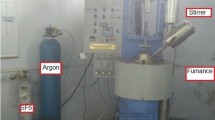Abstract
Aim of the current study is to produce particulates of different size and shape using modulation assisted machining (MAM). In MAM, controlled vibration of high amplitude and low frequency given to the tool helps in breaking the chip–tool contact during machining. Controlled breakage of chip–tool contact produces the chips as particulate at a rate of frequency of modulation. Size and shape of the particles produced by MAM can be controlled by varying modulation and machining conditions. In the current investigation, particulates of different shapes and size ranging from 100 μm to 5 mm and aspect ratio of ∼10 were produced using MAM. Morphology of the particulates produced at different conditions was investigated using scanning electron microscopy and tool maker’s microscope. Vickers’s microhardness testing was done to study and understand the variation of hardness in bulk brass and chip particulates produced using MAM. Nearly a 52 % increase in microhardness was observed in 100-μm-sized chip particulates as compared to bulk material. To confirm this observation, microstructure analysis of bulk brass and chip particulate was done. Refined grain structure of chip particulate might have contributed to the increased hardness of the particulate as compared to bulk. Effect of modulation and machining parameters on deformation level of the chips particulates produced during MAM was also investigated using X-ray diffraction. It has been observed that with decrease in particulate size, internal strain increases and crystallite size decreases.
Similar content being viewed by others
References
Lenel FV (1980) Powder metallurgy: principles and applications. Metal Powder Industries Federation, Princeton
Anthony Fredenburg D, Thadhani NN, Vogler TJ (2010) Shock consolidation of nanocrystalline 6061-T6 aluminum powders. Mater Sci Eng A 527(15):3349–3357
Mann JB, Saldana C, Chandrasekar S, Compton WD, Trumble KP (2007) Metal particulate production by modulation-assisted machining. Scr Mater 57(10):909–912
Mann JB, Guo Y, Saldana C, Yeung H, Compton WD, Chandrasekar S (2011) Modulation-assisted machining: a new paradigm in material removal processes. Sintra p 514–522
Moscoso W, Gun E, Compton WD, Chandrasekar S (2005) Effect of low-frequency modulation on lubrication of chip-tool interface in machining. J Tribol Trans ASME 127(1):238–244
Joshi RS, Singh H (2011) Piezoelectric transducer based devices for development of a sustainable machining system—a review. In: Applications of Ferroelectrics (ISAF/PFM), 2011 International Symposium on and 2011 International Symposium on Piezoresponse Force Microscopy and Nanoscale Phenomena in Polar Materials
Saldana C, Swaminathan S, Brown TL, Moscoso W, Mann JB, Compton WD, Chandrasekar S (2010) Unusual applications of machining: controlled nanostructuring of materials and surfaces. J Manuf Sci Eng 132(3):030908–030912
Hall EO (1954) Variation of hardness of metals with grain size. Nature 173(4411):948–949
Petch NJ (1953) Cleavage strength of polycrystals. J Iron Steel Inst 174:25–28
Chhabra PN et al (2002) Low-frequency modulation-assisted drilling using linear drives. Proc IME B J Eng Manufact 216(3):321–330
Toews HG, Compton WD, Chandrasekar S (1998) A study of the influence of superimposed low-frequency modulation on the drilling process. Precis Eng J Int Soc Precis Eng Nanotechnol 22(1):1–9
Mann J B, Compton CS, Moscoso W D W (2009) Machining method to controllably produce chips with determinable shapes and sizes. US Patent no. 7,628,099
Mann JB, Chandrasekar S, Compton WD (2009) Tool holder assembly and method for modulation-assisted machining. US Patent no 7,587, 965 B2
Williamson GK, Hall WH (1953) X-Ray line broadening from filed aluminium and wolfram. Acta Metall 1:22–31
Cullity BD, Stock SR (2001) Elements of X-ray diffraction, 3rd edn. Prentice-Hall, New Jersey
Biju V, Sugathan N, Vrinda V, Salini S (2008) Estimation of lattice strain in nanocrystalline silver from X-ray diffraction line broadening. J Mater Sci 43(4):1175–1179
Mann JB, Guo Y, Saldana C, Compton WD, Chandrasekar S (2011) Enhancing material removal processes using modulation-assisted machining. Tribol Int 44(10):1225–1235
Mann JB, Saldana C, Compton WD, Farris TN, Trumble KP, Chandrasekar S (2009) Effect of controlled modulation on chip formation and interface tribology in machining. Proc ASME Int Manuf Sci Eng Conf 1:187–191
Bushroa AR, Rahbari RG, Masjuki HH, Muhamad MR (2012) Approximation of crystallite size and microstrain via XRD line broadening analysis in TiSiN thin films. Vacuum 86(8):1107–1112
Langford JI, Leoni M, Scardi P (1998) Standard reference materials for the measurement of instrument resolution functions: effect of transparency. Mater Sci Forum 278–281:278–283
Ungar T, Gubicza J, Ribarik G, Borbely A (2001) Crystallite size distribution and dislocation structure determined by diffraction profile analysis: principles and practical application to cubic and hexagonal crystals. J Appl Crystallogr 34(3):298–310
Lemine OM (2009) Microstructural characterisation of nanoparticles using, XRD line profiles analysis, FE-SEM and FT-IR. Superlattice Microst 45(6):576–582
Sánchez LC, Arboleda JD, Saragovi C, Zysler RD, Barrero CA (2007) Magnetic and structural properties of pure hematite submitted to mechanical milling in air and ethanol. Phys B Condens Matter 389(1):145–149
Pourghahramani P, Altin E, Mallembakam MR, Peukert W, Forssberg E (2008) Microstructural characterization of hematite during wet and dry millings using Rietveld and XRD line profile analyses. Powder Technol 186(1):9–21
Author information
Authors and Affiliations
Corresponding author
Rights and permissions
About this article
Cite this article
Joshi, R.S., Singh, H. Characteristic studies of brass particulates fabricated by modulation assisted machining. Int J Adv Manuf Technol 73, 1533–1542 (2014). https://doi.org/10.1007/s00170-014-5902-8
Received:
Accepted:
Published:
Issue Date:
DOI: https://doi.org/10.1007/s00170-014-5902-8




